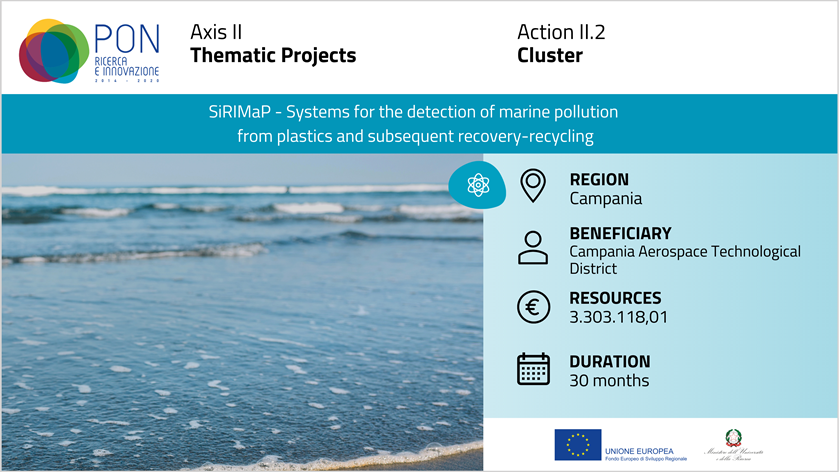Notizie correlate
Non ci sono notizie correlate.
SIRIMAP

ITA | ENG
Project
"SIRIMAP - Systems for the detection of marine pollution from plastics and subsequent recovery-recycling" is mainly aimed at the development of a new system for the detection of marine macro-, meso-, and microplastics by using remote and proximity platforms, sampling systems and methodologies for the analysis of samples both in situ and in the laboratory, and at the development of appropriate recovery and recycling strategies. More specifically, the project aims to develop data analysis methodologies based on the acquisition and processing of satellite imagines to map the floating macro- and mesoplastics in the Mediterranean Sea and for the identification of plastic accumulation zones.
Financial Resources
The project was funded by the NOP Research and Innovation 2014-2020 under Axis II “Thematic Projects”, action “Cluster”, which finances industrial research and experimental development projects in the 12 specialization areas identified by the National Research Programme (NRP) 2015-2020. Campania Aerospace Technological District, IREOS, University of BRESCIA and University of MOLISE received 3.303.118,01 euro in funding for the implementation of this project.
Impact on the Territory
The objectives of the project are particularly relevant for the protection of the Mediterranean Sea, recently identified as a region of plastic debris accumulation. In this scenario, SIRIMAP represents a strategic proposal for the “Blue Growth” specialization area and is in line with the development guidelines defined at global, European and national level. It is reasonable to expect that the know-how acquired in the field of innovative technologies will support the industrial development determining new business scenarios and consequently a positive impact on the territory in terms of employment.
Further Information (in Italian):
Microplastiche: il CNR trova un metodo per scovarle
(da Rinnovabili.it, 24 gennaio 2020)
L'intelligenza artificiale scova le microplastiche in mare
(da Ansa, 23 gennaio 2020)
Olografia digitale e intelligenza artificiale identificano microplastiche in mare
(Comunicato stampa del CNR, 23 gennaio 2020)
26/04/2021








